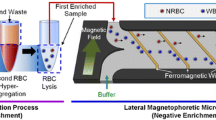Abstract
Objective: To increase the yield of fetal erythroblasts from the blood of pregnant women by optimising and simplifying the enrichment procedure. Methods: By using an experimental system whereby cord blood was mixed with normal adult blood, we evaluated the recovery of fetal erythroblasts using different single or double percoll density gradients with or without subsequent enrichment by Magnetic Activated Cell Sorting (MACS). Results: The recovery of erythroblasts on single density gradients increased from 3%–68% of the input erythroblasts with an increase in the density of percoll from 1075 g/l–1098 g/l. Although the use of a double density gradient did eliminate most lymphocytes, it was accompanied by a significant loss of erythroblasts. The combination with MACS enrichment, however, lead to a almost 200 fold increase in the purity of erythroblasts. Conclusions: Erythroblasts are preferentially retained by higher density gradients. To enhance their purity a subsequent more specific enrichment step, such as MACS is advisable.
Similar content being viewed by others
Author information
Authors and Affiliations
Additional information
Received: 22 January 1999 / Accepted: 14 September 1999
Rights and permissions
About this article
Cite this article
Smits, G., Holzgreve, W. & Hahn, S. An examination of different Percoll density gradients and magnetic activated cell sorting (MACS) for the enrichment of fetal erythroblasts from maternal blood. Arch Gynecol Obstet 263, 160–163 (2000). https://doi.org/10.1007/s004040050273
Issue Date:
DOI: https://doi.org/10.1007/s004040050273




